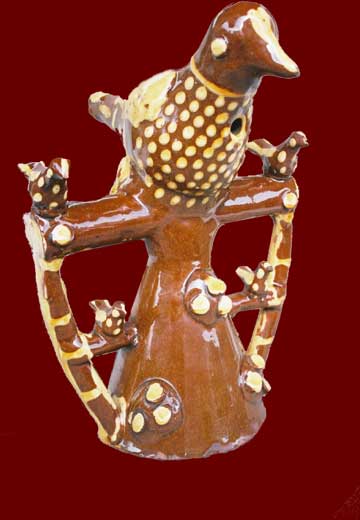 |
: toys or bird calls |
||||||||
The use of the clay whistles is sometimes open to debate. The term of "bird call" often used today to call them lets suppose a use of these objects for hunting. Common sense as well as oral or written evidences go against this assertion. Since Antiquity, the clay whistle belongs to the universe of the toys what does not exclude its sacred nature. |
|||||||||
| Bird calls? The ceramic whistle is frequently called "bird call". A bird call is an instrument being used to imitate the cry or the song of an animal to attract it (to call it). The terms of "cuckoos" or "nightingales" also carry to confusion. These terms are recent. The word of "bird call" is not found before the middle of the 20th century when these objects are forgotten in the collective memory. The words of "cuckoos" and "nightingales", common in the whole Europe, are not attested before the 19th century. In French, many regional words used to call the clay whistles simply derive from the former French word "sublet" used for "sifflet" (whistle). Of course, it is possible that some of these toys were also used as bird calls. Such bird calls are attested in the south of Spain. They are simple globular whistles used for hunting wood pigeons or tubular whistles replacing the metalic whistles in more sophisticated bird calls. Both are ajusted by the potter to the right sound. It seems to stay a local use for the potter or the village inhabitants. Making an effective bird call however requires a great work to adjust it perfectly with the cry of the required animal. The last bird calls makers thus spend several years to carry out a new model of bird call after long hours of observation and listening. We are far from the globular whistle with its two tones quickly turned by the potter. And what can we say about the practical nature of these "clay bird calls". Fragile and cumbersome, many "nightingales" will more likely ensure the hunter to come home empty-handed than attract the birds. |
 English "Cuckoo" Yorkshire 19th century H: 24 cm |
||||||||
| Toys The shape of the old whistles (Bovidae, Russian pagan divinities...) is not opposed to their use as a toy even during the far-off times. The example of Japan is interesting. The Japanese whistles represent divinities of nature. They are offered to the children like toys so that, blowing inside the whistle, they could make profit of the power of the divinity. According to the model of the whistle chosen, one will treat a disease or will attract on him richness, family happiness, etc. Maybe, the old European whistles had such apotropaical use. It is not necessary to point out the sacred nature which had also the toys during antique times. The sources do not distinguish the whistles from the other sound toys. The Gallo-Roman whistle found in a grave in Chalons sur Saone (France) however refers by its form to others rattles of the same period. One knows the protective role of these sound toys of the early childhood.
From the Middle Ages till nowadays, the use of the clay whistles as toys is attested. The oldest document is a decree of the 11th C. taken by Ibn Rusd, cadi of Cordoba, the grand father of the famous Arab philosopher Averroes. He condemned the use of the zoomorphic toys, especially the giraf shaped ones, made in Al-Andalus (Andalucia) for the New Year y other feasts of Christian origins. This decree is quoted within other previous interdictions in a text of the 15th C. against the use of such toys during January in TremecÚn (Algeria). At the 15th century, an Alsatian list of the objects of pottery necessary to a household comprised the whistles for the children. This toy use does not exclude that adult could use clay whistles for other traditions (see "the dialogue for love" or "Feasts and fairs").
|
|||||||||